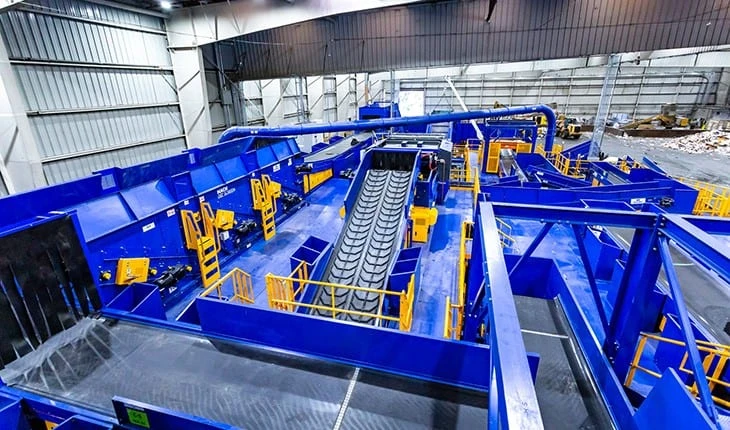
Photo courtesy of Machinex
Canada-based equipment manufacturer Machinex has announced a partnership with Phoenix to deliver a 30-ton-per-hour residential single-stream system in 2023. This project is part of Phoenix’s circular economy and waste diversion initiatives, including diverting most of its recyclables away from its landfill to achieve zero waste by 2050.
To become a circular, zero-waste and carbon-neutral urban area, Phoenix focuses on five pillars: reduce, reuse, recycle, reconsider and reimagine.
Machinex says it will contribute to the city’s objectives by providing a single-stream system to achieve higher recyclable recovery rates. As the city’s project requirements include demanding standards for throughput and sorting quality, Machinex took up the challenge and designed a material recovery facility (MRF) to fit the zero-waste policy, save resources and preserve the environment.
“When operational, this new recycling facility will integrate the latest technologies, including numerous optical sorters, to maximize material recovery while producing high-quality commodities,” says Rick Peters, deputy director of Public Works for the city of Phoenix. “The new facility is designed to be flexible and adaptable, making Phoenix resilient to market and commodity changes over the next 20 years. We also expect this facility to be a great resource to educate students and residents on the value and importance of recycling.”
The MRF is designed to sort recyclables such as paper, cardboard, high-density polyethylene (HDPE), polyethylene terephthalate (PET), polypropylene (PP), mixed plastics and glass from the city’s residential curbside collection program, with a processing capacity of more than 10,000 tons per month. Advanced sorting technology with interconnectivity is necessary to reach high recovery rates without compromising the throughput, Machinex says.
This recycling system, entirely designed and equipped by Machinex, includes a Mach Trommel screen, two Mach Ballistic separators, a SamurAI sorting robot and multiple Mach Hyspec optical sorters to clean papers and fibers while also capturing plastics. To maximize recovery rates while offering higher security for sorters, a Mach Trommel is located at the beginning of the system, before the presort station, to divert small fractions. This allows the smaller fractions to be handled separately while reducing the material burden depth at presort, making for a safer and more efficient sorting position. The small fractions pass immediately by two optical sorters, at the front of the system after the trommel to immediately target small plastics and fiber. The remaining optical sorters within the system clean paper and captures targeted PET, HDPE and PP.
Finally, two Mach Hyspec optical sorters located at the end of the sorting line optimize recovery by capturing any remaining recoverable materials, while cleaned paper goes to a quality control station. The SamurAI sorting robot with integrated AI is performing quality control on plastics. The system also has been designed so additional robots can be added for future needs.
Machinex says its approach to splitting the stream and addressing each fraction separately helps ensure that this system will reach the high recovery rates requested while maximizing the recovery of valuable materials to close the loop and contribute to the city’s zero waste goal.
Latest from Recycling Today
- Nucor receives West Virginia funding assist
- Ferrous market ends 2024 in familiar rut
- Aqua Metals secures $1.5M loan, reports operational strides
- AF&PA urges veto of NY bill
- Aluminum Association includes recycling among 2025 policy priorities
- AISI applauds waterways spending bill
- Lux Research questions hydrogen’s transportation role
- Sonoco selling thermoformed, flexible packaging business to Toppan for $1.8B





